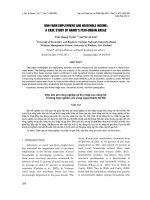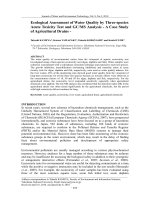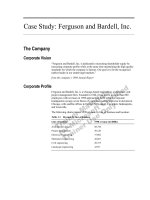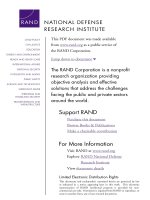16. Case study 4 and 5_Krugman p.206-209
Bạn đang xem bản rút gọn của tài liệu. Xem và tải ngay bản đầy đủ của tài liệu tại đây (133.63 KB, 4 trang )
206
PART TWO International Trade Policy
that at the initial price, the demand for the good exceeds domestic supply plus imports.
This causes the price to be bid up until the market clears. In the end, an import quota will
raise domestic prices by the same amount as a tariff that limits imports to the same level
(except in the case of domestic monopoly, in which the quota raises prices more than this;
see the appendix to this chapter).
The difference between a quota and a tariff is that with a quota, the government receives
no revenue. When a quota instead of a tariff is used to restrict imports, the sum of money
that would have appeared with a tariff as government revenue is collected by whoever
receives the import licenses. License holders are thus able to buy imports and resell them at
a higher price in the domestic market. The profits received by the holders of import licenses
are known as quota rents. In assessing the costs and benefits of an import quota, it is crucial to determine who gets the rents. When the rights to sell in the domestic market are
assigned to governments of exporting countries, as is often the case, the transfer of rents
abroad makes the costs of a quota substantially higher than the equivalent tariff.
Case Study
An Import Quota in Practice: U.S. Sugar
The U.S. sugar problem is similar in its origins to the European agricultural problem:
A domestic price guarantee by the federal government has led to U.S. prices above
world market levels. Unlike the European Union, however, the domestic supply in the
United States does not exceed domestic demand. Thus the United States has been
able to keep domestic prices at the target level with an import quota on sugar.
A special feature of the import quota is that the rights to sell sugar in the United
States are allocated to foreign governments, which then allocate these rights to their
own residents. As a result, rents generated by the sugar quota accrue to foreigners. The
quotas restrict the imports of both raw sugar (almost exclusively, sugar cane) as well as
refined sugar. We now describe the most recent forecast for the effects of the import
restrictions on raw sugar cane (the effects on the sugar refining industry are more complicated, as raw sugar is a key input of production for that industry).3
Figure 9-13 shows those forecasted effects for 2013. The quota would restrict imports to approximately 3 million tons; as a result, the price of raw sugar in the United
States would be 35 percent above the price in the outside world. The figure is drawn
with the assumption that the United States is “small” in the world market for raw sugar;
that is, removing the quota would not have a significant effect on the world price.
According to this estimate, free trade would increase sugar imports by 66 percent.
The welfare effects of the import quota are indicated by the areas a, b, c, and d.
Consumers lose the surplus a + b + c + d, with a total value of $884 million. Part of
this consumer loss represents a transfer to U.S. sugar producers, who gain the producer
surplus a equal to $272 million. Part of the loss represents the production distortion b
($68 million) and the consumption distortion d ($91 million). The rents to the foreign
governments that receive import rights are summarized by area c, equal to $453 million.
The net loss to the United States is equal to the distortions (b + d) plus the quota
rents (c), a total of $612 million per year. Notice that much of this net loss comes from
the fact that foreigners get the import rights.
3
These estimates are based on a report by the U.S. International Trade Commission, The Economic Effects of
Significant U.S. Import Restraints. (Washington, D.C., 2009) cited in Further Readings.
CHAPTER 9 The Instruments of Trade Policy
Figure 9-13
207
Price, $/ton
Effects of the U.S. Import
Quota on Sugar
The quota limits imports of raw
sugar to 3 million tons. Without
the quota, imports of sugar
would be 66 percent higher, or
5.1 million tons. The result of
the quota is that the price of
sugar is $426 per ton, versus the
$275 price on world markets.
This produces a gain for U.S.
sugar producers, but a much
larger loss for U.S. consumers.
There is no offsetting gain in
revenue because the quota
rents are collected by foreign
governments.
Supply
Price in U.S. Market $426
a
World Price $275
b
c
d
Demand
1.8 2.7
5.7 6.9
Quantity of sugar,
million tons
= consumer loss (a + b + c + d)
= producer gain (a)
= quota rents (c)
The sugar quota illustrates in an extreme way the tendency of protection to provide
benefits to a small group of producers, each of whom receives a large benefit, at the expense of a large number of consumers, each of whom bears only a small cost. In this
case, the yearly consumer loss amounts to only about $3 per capita, or a little more than
$11 for a typical family. Not surprisingly, the average American voter is unaware that
the sugar quota exists, and so there is little effective opposition.
From the point of view of the raw sugar producers (farmers and processors), however, the quota is a life-or-death issue. These producers employ only about 6,500 workers, so the producer gains from the quota represent an implicit subsidy of about
$42,000 per employee. It should be no surprise that these sugar producers are very
effectively mobilized in defense of their protection.
Opponents of protection often try to frame their criticism not in terms of consumer
and producer surplus but in terms of the cost to consumers of every job “saved” by an
import restriction. Clearly, the loss of the $42,000 subsidy per employee indirectly provided by the quota would force raw sugar producers to drastically reduce their employment. Without the quota, it is forecasted that 32 percent of the 6,500 jobs would be lost.
This implies that the cost to the U.S. consumer is equal to $432,000 per job saved.
When one also considers that raw sugar is a key input of refined sugar (which is then
used to produce a vast variety of confectionery consumer goods), the costs escalate
even higher. In Chapter 4 we briefly mentioned these costs, which were roughly double
the ones we have summarized here for raw sugar only. When one further considers that
the high cost of sugar reduces employment in those sugar-using industries, the issue is
no longer that the consumer cost per job saved is astronomically high; rather, it is
plainly that jobs are being lost, not saved, by the sugar quota. The U.S. Department of
Commerce has estimated that, for every farming/processing job saved by high sugar
prices, three jobs are lost in the confectionery manufacturing industries.4
4
See U.S Department of Commerce, International Trade Administration, Employment Changes in U.S. Food
Manufacturing: The Impact of Sugar Prices, 2006.
208
PART TWO International Trade Policy
Voluntary Export Restraints
A variant on the import quota is the voluntary export restraint (VER), also known as a
voluntary restraint agreement (VRA). (Welcome to the bureaucratic world of trade policy,
where everything has a three-letter symbol!) A VER is a quota on trade imposed from the
exporting country’s side instead of the importer’s. The most famous example is the limitation on auto exports to the United States enforced by Japan after 1981.
Voluntary export restraints are generally imposed at the request of the importer and are
agreed to by the exporter to forestall other trade restrictions. As we will see in Chapter 10,
certain political and legal advantages have made VERs preferred instruments of trade policy in some cases. From an economic point of view, however, a voluntary export restraint
is exactly like an import quota where the licenses are assigned to foreign governments and
is therefore very costly to the importing country.
A VER is always more costly to the importing country than a tariff that limits imports
by the same amount. The difference is that what would have been revenue under a tariff
becomes rents earned by foreigners under the VER, so that the VER clearly produces a
loss for the importing country.
A study of the effects of the three major U.S. voluntary export restraints of the 1980s—
in textiles and apparel, steel, and automobiles—found that about two-thirds of the cost to
consumers of these restraints was accounted for by the rents earned by foreigners.5
In other words, the bulk of the cost represents a transfer of income rather than a loss of
efficiency. This calculation also emphasizes that, from a national point of view, VERs are
much more costly than tariffs. Given this fact, the widespread preference of governments
for VERs over other trade policy measures requires some careful analysis.
Some voluntary export agreements cover more than one country. The most famous multilateral agreement is the Multi-Fiber Arrangement, which limited textile exports from 22
countries until the beginning of 2005. Such multilateral voluntary restraint agreements are
known by yet another three-letter abbreviation: OMA, for “orderly marketing agreement.”
Case Study
A Voluntary Export Restraint in Practice: Japanese Autos
For much of the 1960s and 1970s, the U.S. auto industry was largely insulated from
import competition by the difference in the kinds of cars bought by U.S. and foreign
consumers. U.S. buyers, living in a large country with low gasoline taxes, preferred
much larger cars than Europeans and Japanese, and, by and large, foreign firms had
chosen not to challenge the United States in the large-car market.
In 1979, however, sharp oil price increases and temporary gasoline shortages
caused the U.S. market to shift abruptly toward smaller cars. Japanese producers,
whose costs had been falling relative to those of their U.S. competitors in any case,
moved in to fill the new demand. As the Japanese market share soared and U.S. output
fell, strong political forces in the United States demanded protection for the U.S. industry. Rather than act unilaterally and risk creating a trade war, the U.S. government
asked the Japanese government to limit its exports. The Japanese, fearing unilateral
5
See David G. Tarr, A General Equilibrium Analysis of the Welfare and Employment Effects of U.S. Quotas in
Textiles, Autos, and Steel (Washington, D.C.: Federal Trade Commission, 1989).
CHAPTER 9 The Instruments of Trade Policy
209
U.S. protectionist measures if they did not do so, agreed to limit their sales. The first
agreement, in 1981, limited Japanese exports to the United States to 1.68 million automobiles. A revision raised that total to 1.85 million in 1984. In 1985, the agreement
was allowed to lapse.
The effects of this voluntary export restraint were complicated by several factors.
First, Japanese and U.S. cars were clearly not perfect substitutes. Second, the Japanese
industry to some extent responded to the quota by upgrading its quality and selling
larger autos with more features. Third, the auto industry is clearly not perfectly competitive. Nonetheless, the basic results were what the discussion of voluntary export restraints earlier would have predicted: The price of Japanese cars in the United States
rose, with the rent captured by Japanese firms. The U.S. government estimates the total
costs to the United States to be $3.2 billion in 1984, primarily in transfers to Japan
rather than efficiency losses.
Local Content Requirements
A local content requirement is a regulation that requires some specified fraction of a final good to be produced domestically. In some cases this fraction is specified in physical
units, like the U.S. oil import quota in the 1960s. In other cases the requirement is stated in
value terms, by requiring that some minimum share of the price of a good represent domestic value added. Local content laws have been widely used by developing countries
trying to shift their manufacturing base from assembly back into intermediate goods. In
the United States, a local content bill for automobiles was proposed in 1982 but was never
acted on.
From the point of view of the domestic producers of parts, a local content regulation
provides protection in the same way an import quota does. From the point of view of the
firms that must buy locally, however, the effects are somewhat different. Local content
does not place a strict limit on imports. Instead, it allows firms to import more, provided
that they also buy more domestically. This means that the effective price of inputs to the
firm is an average of the price of imported and domestically produced inputs.
Consider, for instance, the earlier automobile example in which the cost of imported
parts is $6,000. Suppose that purchasing the same parts domestically would cost $10,000
but that assembly firms are required to use 50 percent domestic parts. Then they will face
an average cost of parts of $8,000 10.5 * $6,000 + 0.5 * $10,0002, which will be reflected in the final price of the car.
The important point is that a local content requirement does not produce either government revenue or quota rents. Instead, the difference between the prices of imports and
domestic goods in effect gets averaged in the final price and is passed on to consumers.
An interesting innovation in local content regulations has been to allow firms to satisfy their local content requirement by exporting instead of using parts domestically.
This is sometimes important. For example, U.S. auto firms operating in Mexico have
chosen to export some components from Mexico to the United States, even though
those components could be produced in the United States more cheaply, because doing
so allows them to use less Mexican content in producing cars in Mexico for Mexico’s
market.









